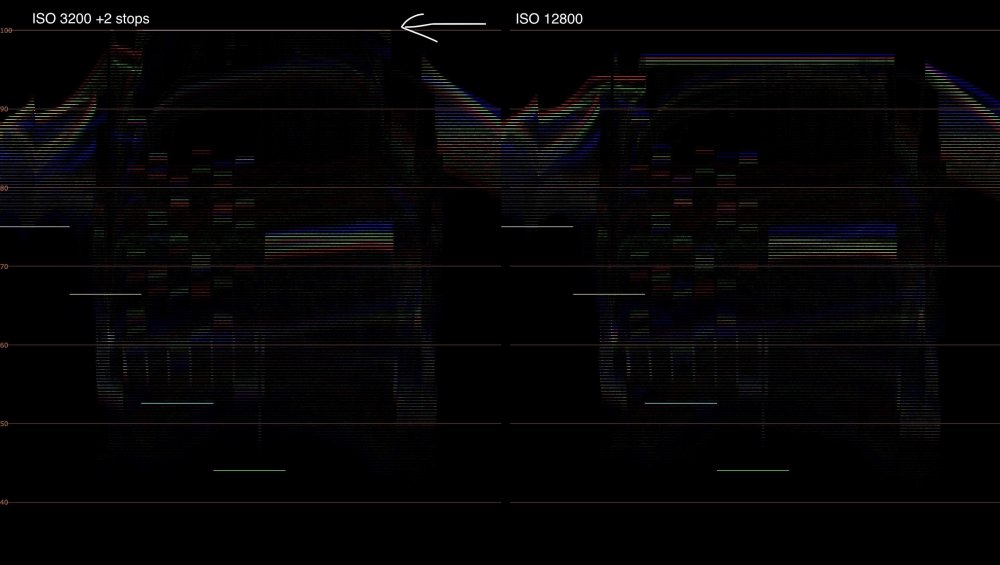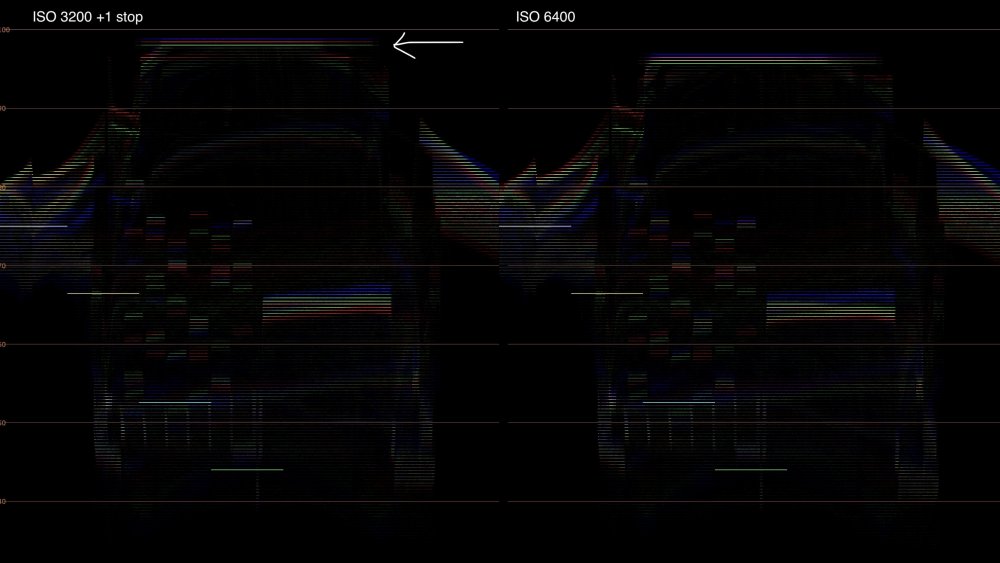Leaderboard
Popular Content
Showing content with the highest reputation on 05/21/2022 in all areas
-

Andrew... you went with a RED?!
zlfan and 2 others reacted to Andrew - EOSHD for a topic
Decided to get a proper RAW cine camera. It was between RED and Blackmagic. The RED seems to have more mojo, especially the older EPIC and Scarlet. I am also trying a RAVEN out. The older REDs are not expensive now. Paid £1790 for an EPIC-X, with 5K 120fps RAW. But when building it out, that's when the costs start rising. But for under $3500 you can definitely get a good kit. It's about the dynamic range and RED raw for me. The colour science is also very nice.3 points -
SIGMA FP with ProRes RAW and BRAW !
Ryan Earl and one other reacted to Llaasseerr for a topic
Here's the highlight clipping without/with highlight recovery based on the just the red channel: ISO 100: 1.0 / 2.09 ISO 200: 2.0 / 4.13 ISO 400: 4.0 / 8.25 ISO 800: 8.0 / 16.1 ISO 1600: 8.0 / 16.1 ISO 3200: 5.0 / 9.92 ISO 6400: 8.0 / 16.48 ISO 12800: 8.0 / 16.73 So the clipping point in the DNG is reached at ISO 800, but it's just due to amplifying the signal by +3 stops from base ISO 100. ISO 800 seems to be the starting point for the Ninja V implementation, which clips at ~9.34. This seems about right since I don't think it uses any kind of highlight recovery. When I balance ISOs 100-800 to the same exposure, they're the same clipping point because 800 hits the max highlight value form that point on. The noise floor actually looks the same to me as well. In this case, ISO 1600 and up are not adding anything in the highlights. ISO 3200 clips earlier than the rest, so ~9.9 vs 16.1, but the noise floor is about the same as ISO 800. If you think about it, there's a net gain here because the highlights are holding about 1/3 stop less than 6400 but the noise floor is -1 stop less. So it's the same as 800, which is really just ISO 100+3 stops). So to me, the way to take advantage of this is to underexpose 3200 by at least 1 stop so you're rating for at least 6400. The effect is that the noise floor is the same as 6400, but the highlights now clip a bit higher. This ISO difference is the same behaviour with the Ninja V at 3200. I'm uploading two waveforms: 1. ISO 3200+1 stop vs ISO 6400. = +1/4 stops more highlight detail. Max value 19.86 vs 16.48 in the red channel, noise floor the same. 2. ISO 3200+2 stops vs ISO 12800 = +1 1/4 stops more highlight detail. Max value 39.7 vs 16.48 in the red channel, noise floor the same. For reference, Alexa's sensor clips at 55 in linearized logC which is only half a stop more, so it seems that the shadow detail would hold up okay if the ISO rating was pushed further. I was going to upload a split screen of the shadow noise, but it honestly looks the same in each image when inspecting each channel individually so take my word for it. It would definitely be interesting in more test images showing the same ISO range at the same exposure level (adjusted with either lens or ND), and also protecting the highlights. It does seem like there's plenty of room to push shadow detail way down and still recover a decent image. EDIT: I just want to clarify that in the +2 stops waveform image (LHS), the highlights are not getting clipped but they're in the upper code values of the log range and can be pulled back.2 points -

SIGMA FP with ProRes RAW and BRAW !
Llaasseerr reacted to Ryan Earl for a topic
Above link doesn't work, this is the correct one: https://we.tl/t-fLzZl7fRNy1 point -

SIGMA FP with ProRes RAW and BRAW !
Llaasseerr reacted to Ryan Earl for a topic
As I did the ISO ramp to 12,800 I went backwards to 100, but only 100, 800, 3200, 12,800 I added 5-8 second clips so you can see the noise, though I didn't match exposure perfectly, I was moving the shutter and aperture for approximately middle gray on the card in the right of the frame. https://we.tl/t-squvulFUOY Thanks for your other feedback, I've been testing 3200 ISO in real world daylight scenes with 4 - 5 stops of ND and will try a few 1 stop underexposed along with your findings.1 point -
If he's serious about making a film then it makes absolute sense. I love mirrorless for practical reasons but for that cinematic aesthetic nothing really beats ARRI, RED, VENICE & VARICAM paired with cine glass imo. There is a reason why they are standards in big productions and not an A7S3, R5C, GH5 etc. Hopefully he will share with us what pushed him in that direction!1 point
-
SIGMA FP with ProRes RAW and BRAW !
OleB reacted to Llaasseerr for a topic
I'm just noticing the shadow levels are getting a little lost at the bottom of the waveform for the pushed 3200 image, so despite the fact it looked visually the same to me when inspecting noise per channel, it evidently is throwing a bit of detail out in service of the highlights. It will be interesting to see how the deepest shadows hold up if the image is shot -2 stops or more underexposed. Also, sorry for the numerous typos in the above post.1 point -
Yeah the Ursa takes two 11bit signals while ALEV is taking two 14 bit signals. The URSA doesn't have the highlight retention of an Alexa and the shadows suffer from fixed noise pattern (noticeable when shooting 1600 in dim conditions). This was apparently less of a problem on the G2 though. Still pretty respectable dynamic range.1 point
-

Andrew... you went with a RED?!
webrunner5 reacted to IronFilm for a topic
I've got a friend who loves the look of his RED ONE M! (yes, the M, not the MX) There is a taste to suit everyone.1 point -
Pretty nice video about the 2022 NAB show. Lots of nice toys there to buy.
webrunner5 reacted to mercer for a topic
Glad you're enjoying the phone, but I prefer the 1DC shots. The bottom one is fantastic!1 point -
All RED cameras have a kind of different look IMO. The Scarlet Dragon is nice though not really accurate especially under tungsten. It's a nice look though and redraw is super easy to work with.1 point
-
Andrew... you went with a RED?!
mercer reacted to newfoundmass for a topic
I'm very interested in his thoughts/impressions!1 point -

Panasonic GH6
Juank reacted to hyalinejim for a topic
The answer, from looking at the manual, is no. There is an EX Tel Conv. mode but it doesn't work for video on the GH6. So there's no sweet 2x mode for HD shooters. It looks to me that the only thing that comes close for 1080p is to set a custom mode to shoot 4K pixel/pixel and then scale it 50% in post to give a clean 1.5x zoom on a HD timeline. Or you could scale it to 75% which should give you a clean 2x digital zoom. But of course, then you end up dealing with 4K files anyway which defeats the purpose of shooting HD. And also there's a bit of post work involved. And if you're aiming for the 2x then framing will be wider than what you want. The beauty of the GH5's 2x Digital Zoom for HD was you just pressed a function button and the reach of your lens doubled.1 point -

Panasonic GH6
kye reacted to hyalinejim for a topic
What do you guys think about the Freewell Vari ND magnetic kit for GH6 with DR Boost on? It splits a Vari ND into its components which means you can do this: - Mount the base ring which is one stop reduction, effectively base ISO is now 1000 - Add 2-5 Vari ND for shooting indoors - Swap it for 6-9 when shooting outdoors (9 stops, if it's actual, is enough for me even in bright light as I'm not usually looling for very narrow DOF) Looks like the colour cast is minimal but I haven't found much info on X pattern just yet. They also do solid NDs which stack and I could get a 3 and 6 or some other combo. But I think I would give up a little image quality for the convenience of fine tuning exposure with a variable system.1 point -

Andrew... you went with a RED?!
Xavier Plagaro Mussard reacted to webrunner5 for a topic
Probably drinking too much of that strong Berlin beer.1 point -
I had a vague recollection about the OG pocket / BMMCC being dual-gain, but didn't know the Ursa 4.6k ones were too. The Ursa's are S35 aren't they? I wonder how the DR compares to the ALEV.1 point
-
I love how you tell us what you're going to eat when you read articles. It's as if a certain food goes well with a certain camera... with fava beans and a nice chianti.1 point
-

Panasonic GH6
solovetski reacted to kye for a topic
No, that's Dual Native ISO, not Dual Gain like the GH6 is. Dual Native ISO is when the camera has two native ISO values that it can choose from and picks the best one to use at any given time. Dual Gain (in the sense of the ALEV, Canon DGO, and GH6) is when the sensor has two outputs that each have a different gain and those two outputs are used simultaneously and combined with each other to create a higher DR image, in-camera, in realtime. This is the info from ARRI - https://www.arri.com/en/learn-help/technology/alev-sensors It's something people get confused between, because it's so rare and.... innovative.1 point -
Lomo anamorphic on a Red Dragon. Well, that´s a Tarkovksian Hollywood image. Cannot wait. Comparison with the GH6 woud be a great article to enjoy on a Sunday morning with coffee, and scrambled eggs with grilled tomatoes. 🙂1 point
-

Canon EOS R5C
Juank reacted to hyalinejim for a topic
Yep, that GH6 grain is very film-like. R5C 10bit looks like there is heavy temporal NR going on which causes that unnatural shimmering, especially when you compare it to the RAW output which is noisy but doesn't shimmer.1 point -
Yeah, the Komodo is an amazing little camera. But like you said, there are some crazy deals out there. I often look to see how much the original Scarlet or Raven is going for.1 point
-
Well, he said he wanted to make a film. These hybrids can only take you so far. Hopefully, he'll update us on his process of building a rig. The Dragon is a fairly small camera, so it will be interesting to see how compact he can keep it.1 point
-

Andrew... you went with a RED?!
kye reacted to webrunner5 for a topic
https://twitter.com/EOSHD/status/1524714142275452930/photo/1 I would have bought a Komoto if it was close to the same price, but there are some crazy deals on the older stuff to be had.1 point



